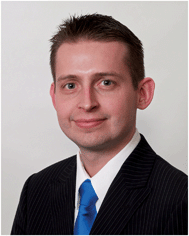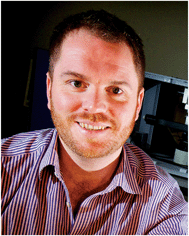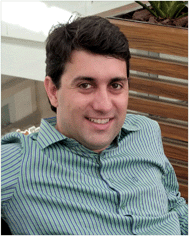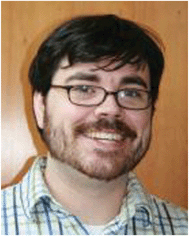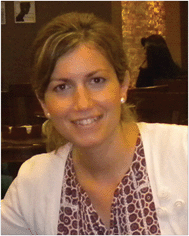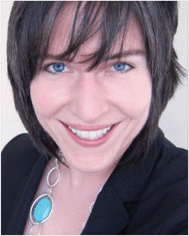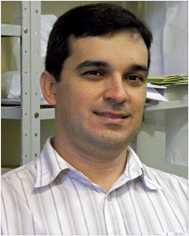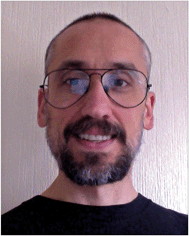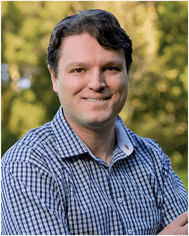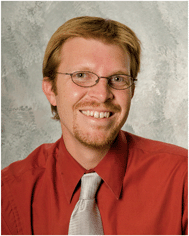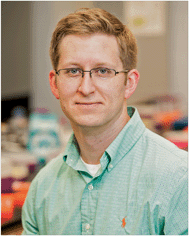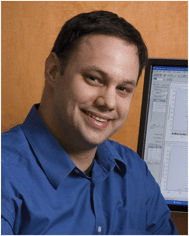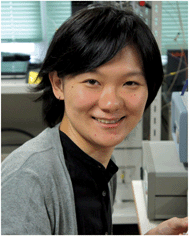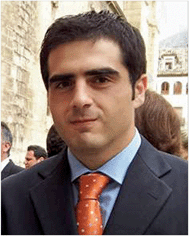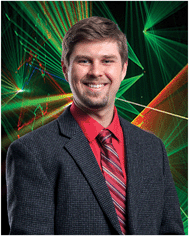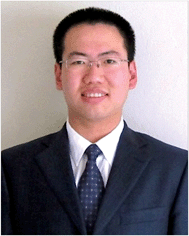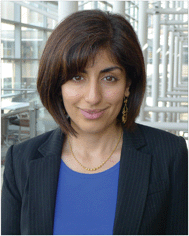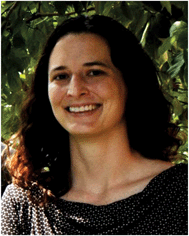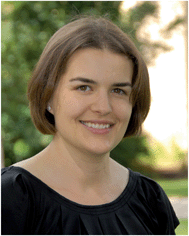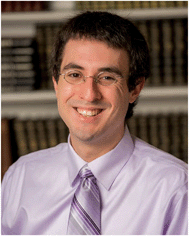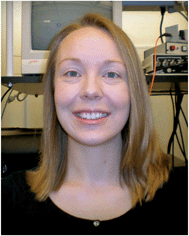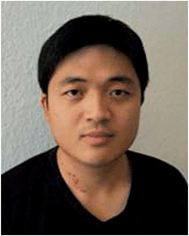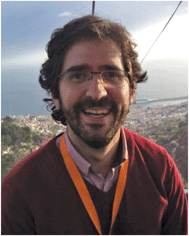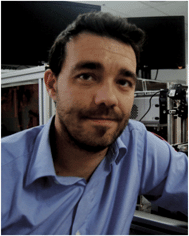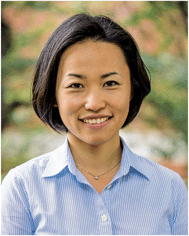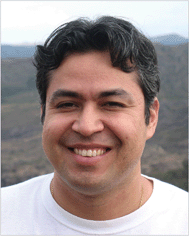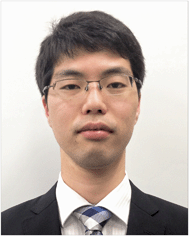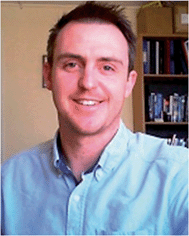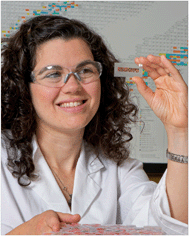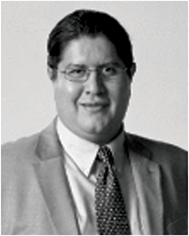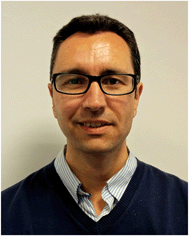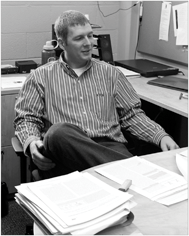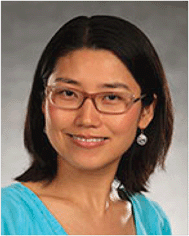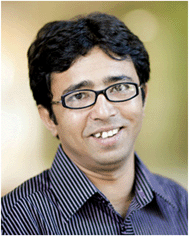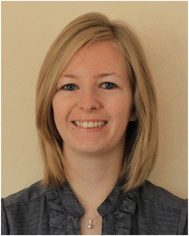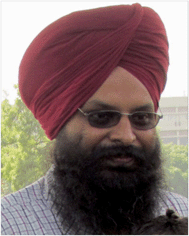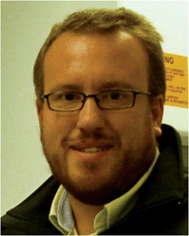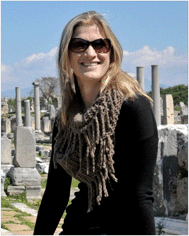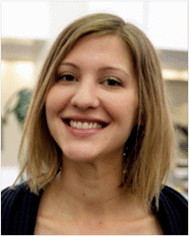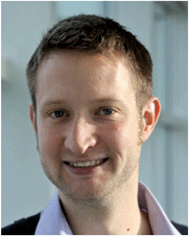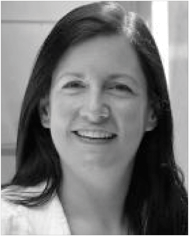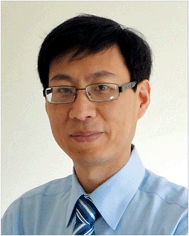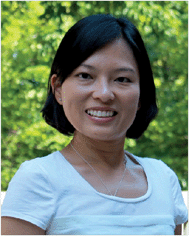DOI:
10.1039/C5AY90060C
(Profile)
Anal. Methods, 2015,
7, 6937-6946
Contributors to the emerging investigators issue
Jared L. Anderson obtained his B.S. degree in chemistry from South Dakota State University in 2000 and his Ph.D. in analytical chemistry from Iowa State University in 2005. He joined the chemistry department at The University of Toledo in August 2005 and rose through the ranks as assistant professor, associate professor, and full professor. In August 2015, he joined the chemistry department at Iowa State University as a full professor of chemistry. Anderson was the recipient of an NSF CAREER Award, Emerging Leader in Chromatography Award given by LCGC Magazine, and the American Chemical Society Young Investigator in Separation Science Award. His research interests include all aspects of separation science, the synthesis of new classes of ionic liquids and materials derived from polymeric ionic liquids, the use of ionic liquids as catalytic solvents, and the use of ionic liquids in analytical extractions, purification, and chromatography.
Matt Baker obtained his Ph.D. from the Department of Chemical Engineering and Analytical Science, University of Manchester based in the Manchester Interdisciplinary Biocentre. Following this he was awarded an EPSRC Fellowship conducting research at the Robert Koch Institute and Harvard Medical School. He was then a Project Manager, Senior Scientist and Research Fellow for Dstl and Senior Lecturer at UCLan. He is currently a Senior Lecturer in the Department of Pure and Applied Chemistry, University of Strathclyde based in the Technology Innovation Centre. His research aims are to understand the composition and behavior of molecules within complex matrices related to real-world detection challenges.
Keyller Bastos Borges obtained a B.Sc. degree in Pharmacy at the Federal University of Alfenas, an M.Sc. in Toxicology and a Ph.D. in Sciences at the University of São Paulo in Ribeirão Preto. He has been Adjunct Professor at the Department of Natural Sciences, University of São João del-Rei since 2011. His main research interests comprise different areas including spectrophotometry, separation techniques and mass spectrometry as well as the development of new microextraction techniques and new materials for sample preparation and separation.
Sean M. Burrows is an Assistant Professor in the Department of Chemistry at Oregon State University. He received his Ph.D. training from D. Pappas at Texas Tech University and postdoctoral training from T. Vo-Dinh at Duke University. The Burrows group focuses on innovative
in-situ biosensors and ultrafast laser-based technologies to improve imaging of cellular regulatory biomarkers. Current biomarkers of interest are long non-coding RNAs and microRNAs. Ultimately, his group aims to bridge bioanalytical chemistry, spectroscopy, plasmonics, and molecular biology to solve complex biological problems associated with understanding disease progression
Alegría Carrasco is an associate professor of the Department of Analytical Chemistry at the University of Granada. Her doctoral thesis focused on the evaluation of different methodologies for determining phenolic compounds from olive oil. Between 2007 and 2009 worked as postdoctoral researcher at Leiden University Medical Center (The Netherlands), assessing the performance of new interfaces for GC–MS and sheathless sprayers for CE–MS. Nowadays, her main activities are related to the development and evaluation of MS-based analytical strategies (GC–MS, LC–MS and CE–MS) in combination with powerful statistical tools for the characterization of the metabolome of both biological fluids and food extracts.
Shelley A. Claridge is an Assistant Professor in the Department of Chemistry and the Weldon School of Biomedical Engineering at Purdue University. She completed her Ph.D. in Chemistry at UC Berkeley in 2008 with A. Paul Alivisatos and Jean M. J. Fréchet, and was an NIH Postdoctoral Fellow and Mirkin Family Postdoctoral Fellow with Paul S. Weiss at UCLA and Penn State University, developing custom multimodal scanning probe techniques for applications in biology. Her work at UCLA was recognized with the UCLA Chancellor's award for Outstanding Postdoctoral Research and the UCLA Molecular Biology Institute Award for Postdoctoral Research.
Wendell Coltro is an Assistant Professor in Analytical Chemistry at the Federal University of Goias, Brazil. He obtained his Ph.D. in Analytical Chemistry (2008) under the supervision of Professor Emanuel Carrilho at the University of São Paulo (Brazil). During his Ph.D., he was a visiting scholar at The University of Kansas (USA) under the supervision of Professor Sue Lunte. His research interests involve the development of toner and paper microfluidic devices for bioanalytical studies using electroanalytical methods or digital image analysis. In 2014, he was nominated as one of the ten innovators under the age of 35 in Brazil by
MIT Technology Review magazine.
Susan Daniel is an associate professor in the School of Chemical and Biomolecular Engineering at Cornell University. She received her Ph.D. degree in chemical engineering from Lehigh University in 2005 and spent two years as a postdoctoral fellow in chemistry at Texas A&M University before beginning her academic career at Cornell in 2007. Her research interests fall in the fields of membrane biophysics, biological interface engineering, and biotechnology. Her laboratory currently investigates interfacial phenomena ranging from lipid–protein to host–pathogen interactions.
Roberto de la Rica did his Ph.D. at the National Centre for Microelectronics in Barcelona in the field of biosensors. He has been a Lecturer in Bionanotechnology at the University of Strathclyde since October 2013. His laboratory focuses on the fabrication of bioengineered nanosensors that can perform analyses with minimal human intervention for applications in health care and bioimaging. This is accomplished by confining biomolecular tools on the surface of inorganic nanoparticles, and activating or suppressing their functions through biomolecular recognition and biocatalysis.
William A. Donald, known as “Alex” by friends and colleagues, joined the School of Chemistry at the University of New South Wales Australia in 2013 after two years as the Centenary Research Fellow in Richard O'Hair's laboratory at the University of Melbourne, Australia. Alex is a graduate of UC Berkeley (Ph.D. 2010), where he was a member of Evan Williams's Biological Mass Spectrometry and Biophysical Chemistry Laboratory. He has received a prestigious Australian Research Council Discovery Early Career Researcher Award, an IUPAC Prize for Young Chemists, and the inaugural Michael Guilhaus Research Award. The Donald Group develops and applies instrumentation, methods, and theory in mass spectrometry to fundamental problems in chemistry and biochemistry.
Jeremy Driskell earned a B.S. in chemistry from Truman State University (2001) and completed a Ph.D. at Iowa State University under the advisement of Marc D. Porter (2006). From 2006 to 2011 he served as a post-doctoral research associate and research scientist at the University of Georgia developing novel SERS substrates for sensing infectious diseases. In 2011, Jeremy joined Illinois State University as an assistant professor of chemistry and in 2013 he received a Defense Threat Reduction Agency Young Investigator Award. His current research interests include the development of novel SERS platforms for bioanalytical applications and antibody–antigen binding kinetics. Website: http://chemistry.illinoisstate.edu/jdriske/default.shtml.
Christopher J. Easley is currently the C. Harry Knowles Associate Professor of Chemistry and Biochemistry at Auburn University. He received his B.S. degree in chemistry at Mississippi State University in 2002 and his Ph.D. in bioanalytical chemistry and microfluidics from the University of Virginia in 2006, under training from Prof. James P. Landers. His postdoctoral training was provided by Prof. David W. Piston at the Vanderbilt University Medical Center in the Department of Molecular Physiology and Biophysics, from 2006 to 2008, and he has been at Auburn since 2008. Prof. Easley is an author on 27 manuscripts, 3 issued patents, and 2 book chapters. His early work focused on capillary electrophoresis, integrated microfluidic genetic analysis, and microfluidic circuit analogies. At Auburn University, the Easley laboratory develops microfluidic methods and small-volume protein assays using aptamers and antibodies to study secretions from small numbers of cells in intact, primary tissue. Current studies are focused on dynamic functions of adipose tissue and pancreatic islets in rodent models of human disease. Debilitating conditions such as diabetes, obesity, and metabolic syndrome are fundamentally linked to these tissues.
James L. Edwards received B.A. and M.S. degrees in chemistry from Saint Louis University. He earned a Ph.D. at the University of Michigan under the guidance of Robert T. Kennedy and later performed post-doctoral research at the Juvenile Diabetes Research Foundation Center for the Study of Complications in Diabetes under the direction of Eva Feldman. He was previously on staff at the University of Maryland and has been an assistant professor in the chemistry department at Saint Louis University since 2012. His research group develops metabolomic methods focused on advancing sample processing, capillary separations and mass spectrometry for diabetes research.
Mao Fukuyama was born in Tokyo, Japan, in 1985. She completed a Ph.D. at the University of Tokyo, Japan, in 2014. She then worked in the group of Prof. Hibara at the Tokyo Institute of Technology as a post-doc, where her studies were on the interface chemistry of microdroplets in microfluidics. She is currently an Assistant Professor at the Kyoto Institute of Technology, Japan.
Juan F. García-Reyes has been an Associate Professor of Analytical Chemistry at the University of Jaén (Spain) since 2010. His current research interests are the development abd application of different UHPLC-HRMS methodologies for small-molecule applications such as environmental analysis, food quality and safety testing and forensics, and the use of new ambient and atmospheric pressure ionization methods based on dielectric barrier discharges for mass spectrometric small-molecule applications such as pesticide testing and explosive detection. He is co-author of
ca. 95 peer-reviewed journal articles, which have received over 2600 citations (
h-index 30) and has presented over 150 contributions in analytical chemistry-related conferences. Webpage: http://www4.ujaen.es/%7Ejfgreyes/
Edgar D. Goluch received his B.S. in Chemical Engineering from the University of Illinois at Urbana-Champaign. He remained at Illinois for graduate school, receiving a MS in Mechanical Engineering and Ph.D. in Bioengineering. From 2008 to 2010, Ed was an NSF Postdoctoral Fellow at Delft University of Technology in the Netherlands. Since 2010, Ed has been the DiPietro Assistant Professor of Chemical Engineering at Northeastern University. Ed has published over 50 peer-reviewed journal articles, conference proceedings, and patent applications in the areas of microfluidics, sensors, and biophysics. His group is currently developing micro/nano-fluidic devices and sensor technology to study bacterial cells and biofilms.
Jia Guo received his B.S. degree from the University of Science and Technology of China in 2005, and his Ph.D. degree from Columbia University in 2009. After doing postdoctoral research at Stanford University, he joined Arizona State University in 2013, where he is currently Assistant Professor of Chemistry and Biochemistry. His research focuses on the development of single cell genomics and proteomics technologies with novel fluorescent probes, which will enable the systematic analysis of the identities, positions and abundances of a large number of different biological molecules in individual cells in structured tissues.
Parastoo Hashemi obtained her M.Sc. degree in King's College London in Chemistry, graduating 2nd in her class. She performed her Ph.D. in the Biomedical Engineering department in Imperial College London where she developed biosensors to monitor the spread of brain damage in human traumatic injury patients. During this time, she spent one year performing a collaboration in the Max Plank Institute in Köln, Germany and a further collaboration year in the Panum Institute in Copenhagen, Denmark. Her post-doctoral work was carried out in the University of North Carolina, Chapel Hill, North Carolina where she developed microelectrodes to measure neurotransmitters
in vivo. Dr Hashemi has maintained her own independent research program for 4 years as an assistant professor, first in the department of Chemistry at Wayne State University and now in the Department of Chemistry at the University of South Carolina. Her group design and fabricate ultra sensitive sensors for rapid detection of molecules in biology and the environment.
Leslie Hicks received her B.S. (Marshall University) and then Ph.D. (University of Illinois, Urbana-Champaign) in Chemistry with Neil Kelleher as an NSF graduate research fellow. She moved to the Danforth Center as Director of the Proteomics & Mass Spectrometry Facility and became a Principal Investigator in 2012. In 2013, she became Assistant Professor in the Department of Chemistry at UNC Chapel Hill, and received the 2014 Arthur C. Neish Young Investigator Award. Research in the Hicks lab focuses on mass spectrometric approaches for protein characterization including post-translational modifications in photosynthetic organisms, as well as the identification of bioactive peptides/proteins.
Amanda B. Hummon received her bachelor's degree in Chemistry from Cornell University in 1999. She performed graduate research in the laboratory of Jonathan V. Sweedler at the University of Illinois, using mass spectrometry to study the neuropeptides in
Aplysia californica neurons. After obtaining her doctorate in 2004, she completed a post-doctoral fellowship at the National Cancer Institute. She started her independent laboratory in the Department of Chemistry and Biochemistry at the University of Notre Dame in 2009. Her laboratory develops analytical methods to evaluate both the transcriptome and the proteome in colon cancer cells, while exploring the deregulation in cancer-associated signal transduction pathways.
Richard B. Keithley received his bachelor's degree in Chemistry from Virginia Commonwealth University in 2006. He received his Ph.D. in Analytical Chemistry from the University of North Carolina at Chapel Hill in 2011 under the direction of Mark Wightman where he developed electrochemical tools for the detection of neurochemicals
in vivo. Afterwards, he undertook post-doctoral research in the laboratory of Norman Dovichi at the University of Notre Dame. He is currently an Assistant Professor of Chemistry at Roanoke College where he and his undergraduate students are developing novel electrochemical, separation, and chemometric tools for the analysis of intriguing biomolecules.
Michelle Kovarik obtained her B.S. in chemistry from Saint Louis University, where she became involved in undergraduate research on microfluidics. This experience inspired her graduate work at Indiana University on the design, operation, and application of nanofluidic devices. After a side project on bacterial chemotaxis, she became interested in cellular heterogeneity, pursuing postdoctoral work at the University of North Carolina involving single-cell enzyme assays on microfluidic devices. During her postdoc, Dr Kovarik was part of the Seeding Postdoctoral Innovators in Research and Education (SPIRE) program, allowing her to integrate research and teaching during two semesters at North Carolina A&T State University. As a new faculty member at Trinity College, she is excited to share her passion for precise chemical measurements of biochemical systems with her undergraduate colleagues.
Po-Chiao Lin (1979, PingTung, Taiwan) received his Ph.D. at Taiwan International Graduate Program in 2008 with Prof. Chun-Cheng Lin. In 2010, he completed a post-doctoral appointment with Prof. Herbert Waldmann at the Max-Planck-Institute for Molecular Physiology (Dortmund, Germany) and was appointed as assistant professor of organic chemistry at National Sun Yat-sen University. He is now an associate professor of organic chemistry. His research interests are in organic synthesis, analytical methods and protein chemistry.
Rafael Lucena has been professor of Analytical Chemistry at the University of Córdoba since 2010. His main research interest comprises the development of new microextraction techniques and the evaluation of the potential of novel materials (ionic liquids, nanoparticles and biomolecules) in this context. He has co-authored about 70 scientific articles and 4 chapters of books in this field. In addition, he is the Editor of the Microextraction Tech blog dedicated to divulgation. Since 2012, he has also been working on the development of analytical strategies for the early detection of pests which is a critical economic and social problem.
Javier Moros obtained his doctorate in Chemical Science at the University of Valencia (2007). Since 2008 he has held a postdoctoral scientist position in the Laser Laboratory led by Prof. Dr J. Laserna at the University of Málaga (UMA). He was awarded an
accésit at the VI Research Awards of the General Foundation of UMA for the best research article published in the area of Sciences (2013). His research focuses on the remote applicability of optical sensing techniques – LIBS and Raman spectroscopy, the design, implementation and assessment of chemometrics approaches for better exploiting these techniques, and the plasma chemistry of molecular solids.
Hitomi Mukaibo is an Assistant Professor at the Department of Chemical Engineering at the University of Rochester. She is also associated with the Department of Chemistry and the University of Rochester Advanced Materials Program (RAMP). Hitomi received her Ph.D. in Applied Chemistry from Waseda University in 2006, where she was also a Research Fellow of the Japan Society for the Promotion of Science. She worked as a postdoctoral associate at the University of Florida from 2008 to 2011. Her research interests cover various disciplines in materials science, including energy storage materials, electrochemistry, biosensors, and gene delivery platforms.
Christopher C. Mulligan is an Associate Professor of Analytical Chemistry at Illinois State University, where his research is focused on applying and adapting portable mass spectrometric instruments for use in areas of societal need. Through recent National Institute of Justice funding, Dr Mulligan and his research group, which is comprised of master's-level graduate and undergraduate students, demonstrated the utility of such instrumentation towards crime-scene investigation and routine evidence analysis.
Rodrigo Alejandro Abarza Muñoz is graduated in Chemistry from the University of São Paulo, Brazil (2002), and received his Ph.D. in analytical chemistry from the same university in 2006. He completed a postdoctoral research at the Arizona State University (USA) during 2006–2007 and a postdoctoral research at the University of São Paulo during 2007–2008. He is currently Professor of Chemistry at the Federal University of Uberlândia, Brazil. His current research interests focus on the development of new analytical methods and sensors emphasizing the use of modified electrodes associated with flow-injection and batch-injection analyses for food, fuel and pharmaceutical samples.
Toyohiro Naito received his B.S., M.S., and Ph.D. degrees in the Department of Applied Chemistry, Nagoya University, Japan in 2008, 2010, and 2013 respectively. He moved to Kyoto University as an assistant professor at the Department of Material Chemistry in 2013. He engaged in research on the development of microfluidic devices for cell biology procedures such as cell culture, and DNA amplification. His current research interests are three-dimensional microfabrications and microfluidics, and their applications.
Scott Phillips is the Martarano Associate Professor of Chemistry at the Pennsylvania State University. He earned his Ph.D. from Paul A. Bartlett at UC Berkeley in 2004 and trained as a postdoctoral fellow in the group of George Whitesides (Harvard). He started his independent career at Penn State in 2008. His research interests include signal amplification, global health, point-of-need diagnostics, polymer chemistry, sustainability, stimuli-responsive materials, bio-inspired materials, and polymer recycling.
Mark Platt graduated with a degree in Chemistry and Analytical Chemistry from the University of Salford in 2001. He moved into the area of liquid/liquid electrochemistry with Prof. R. A. W. Dryfe and obtained his Ph.D. in 2004 from the University of Manchester. He spent time as a postdoc in Penn State (USA), Cambridge then Manchester (UK) and finally Dublin (Ire) before taking up an academic position at Loughborough University. His research interests sit at the interface between materials, electrochemistry and analytical chemistry developing sensors for health and wellbeing.
Rachel Popelka-Filcoff is an Australian Institute of Nuclear Science and Engineering (AINSE) Senior Research Fellow in the School of Chemical and Physical Sciences at Flinders University. Her primary research interests are in the novel application of radioanalytical and spectroscopic methods on complex samples towards answering multidimensional archaeological science, environmental and forensic questions. Her research is the first comprehensive characterisation of Australian Aboriginal natural mineral pigments on cultural heritage materials by several advanced analytical methods. Rachel has received awards for her research including the South Australian Tall Poppy of the Year in 2012, which recognises to top early career researcher in the state.
Joaquín Rodríguez-López has been an Assistant Professor of Chemistry at the University of Illinois since 2012. He obtained a Ph.D. in analytical chemistry from the University of Texas at Austin with Prof. Allen J. Bard (2010), and did post-doctoral research at Cornell University with Prof. Héctor D. Abruña. His group advances nano-interrogation methods for elucidating reactive heterogeneity and chemical intermediates at electrodes for photocatalysis and ion storage. The Rodríguez-López group also develops next-generation redox flow batteries and ultrathin graphene-based electrode platforms. An emerging investigator, Joaquín aspires to create distinctive tools and powerful strategies that advance green and high-performance energy materials.
Roberto Romero-González received his Ph.D. from the University of Granada (Spain) in 2002 in Chemistry. After two years of postdoctoral work at the University of Lund (Sweden), he joined the research group ‘Analytical Chemistry of Contaminants’ (University of Almeria, Spain). Since December 2008, he has been awarded several contracts (
i.e. Ramon y Cajal Program) as senior researcher at the University of Almeria. Nowadays, he has been co-author of more than 80 research papers published in international journals related to the determination of bioactive compounds, contaminants and organic residues in environmental and food matrices, applying chromatographic techniques coupled to mass spectrometry analysers.
Scott K. Shaw joined the Chemistry faculty at the University of Iowa in the fall of 2012 as an Assistant Professor. Scott is native to the rural American Midwest and received bachelor degrees in chemistry and education from Monmouth College in Monmouth Illinois. He completed his doctoral training in Chemistry under Andy Gewirth (UIUC) using non-linear spectroscopy to study electrochemically driven interfacial processes. He held postdoctoral positions with Colin Bain (Durham, UK), and David Schiffrin (Liverpool, UK), and was later awarded an NSF Postdoctoral Fellowship while working with Jeanne Pemberton (Univ. of Arizona at Tucson). His growing research group at Iowa focuses on the analysis of interfacial fluids and thin films utilizing spectroscopy, microscopy, and electrochemical methods. Current projects include measuring the structures and properties of ionic liquid interfaces, developing chemical systems for CO
2 recycling, and examining the role of environmentally active surface films in the fate and transport of persistent organic pollutants.
Mei Shen is an Assistant Research Professor of Chemistry at the University of Illinois at Urbana-Champaign. She completed her Ph.D. work at The University of Texas at Austin with Prof. Allen J. Bard and postdoctoral work at University of Pittsburgh with Prof. Shigeru Amemiya. Since arriving at University of Illinois at 2012, her group's research has been interdisciplinary across nanoelectrochemistry and neuroscience. Her group is developing novel nanosensor probes to detect a broad range of neurotransmitters. Another research focus in her laboratory is nanometer spatial resolution imaging of neurotransmission at single neuronal structures with scanning electrochemical microscopy and nanoelectrodes.
Muhammad Shiddiky is currently an Associate Group Leader and National Health and Medical Research Council (NHMRC) Career Development Research Fellow at the Australian Institute for Bioengineering and Nanotechnology (AIBN), The University of Queensland (UQ). Prior to joining the group of Professor Matt Trau at the AIBN, he was a postdoctoral research fellow in the School of Chemistry at Monash University. He has co-authored more than 50 journal publications, many of which appear in the top journals in the fields of chemistry, electroanalytical chemistry, and biosensors. His major awards and honours include an ARC Discovery Early Career Researcher (DECRA) Fellowship, an NHMRC CDF, a UQ Postdoctoral Research Fellowship, a UQ ECR Award, and a Graduate Student Award for Ph.D. research excellence (from Pusan National University, South Korea). He has two patents at the PCT stage.
Debbie Silvester is a Senior Research Fellow in the Department of Chemistry, Curtin University, Perth, Australia. She co-heads the Electrochemistry and Sensors group with Professor Damien Arrigan. She completed her Ph.D. in December 2008 under the supervision of Professor Richard Compton at the University of Oxford, UK. She had published more than 40 journal articles and has a
h-index of 21. Her current research interests are focused on the electrochemical behavior and sensing of toxic gases and explosives in ionic liquids, liquid/liquid electrochemistry with ionic liquids and synthesis of mesoporous metal structures for hydrogen storage applications.
Narinder Singh obtained his Ph.D. degree from Guru Nanak Dev University, Amritsar. After spending 3 years as Postdoctoral fellow, he joined Indian Institute of Technology Ropar (IIT Ropar) as Assistant Professor of Inorganic Chemistry. Currently, he is the Coordinator, Chemistry Department of Indian Institute of Technology Ropar. He has published more than 125 research papers in international peer-reviewed journals. His area of research includes supramolecular and materials chemistry.
Paul G. Stevenson is a research fellow at Deakin University, Geelong, Victoria, Australia. In September 2010 he graduated from the University of Western Sydney, Australia with a Ph.D. before completing a postdoctoral appointment at the University of Tennessee, USA. Paul returned to Australia after being selected for a prestigious Alfred Deakin Postgraduate Research Award from Deakin University. Paul's research is centred on two-dimensional high performance liquid chromatography where he investigates column selection and interfacing separation environments. Of particular interest is the design of algorithms to streamline data analysis and expand instrumental capability beyond its intended limits.
Jenn Stockdill completed her B.S. in Chemistry at Virginia Tech in 2003. She completed a Ph.D. in Chemistry in 2009 under the guidance of Prof. Brian M. Stoltz at Caltech. Her thesis work focused on the synthesis of the bioactive marine alkaloid zoanthenol. She then joined the group of Prof. Samuel J. Danishefsky at the Sloan-Kettering Institute at MSKCC. Jenn joined the faculty at Wayne State University as an Assistant Professor in July 2012. Jenn's research program focuses on novel reaction methods and strategies for the synthesis of neuroactive peptides and small molecules and the development of new chemical probes.
Megan Thielges is an assistant professor in the Department of Chemistry at Indiana University. She received her Ph.D. in biophysics at The Scripps Research Institute (La Jolla, CA) in 2009 and completed postdoctoral studies in multidimensional IR spectroscopy at Stanford University before joining the faculty at Indiana University in 2012. Her research focuses on applying and developing linear and multidimensional infrared spectroscopy in combination with chemical and biological methods for site-selective protein labeling to generate residue-specific descriptions of protein dynamics and delineate their contributions to function. A central research interest is molecular recognition and how dynamics might tailor its specificity.
Andy Wain received his Masters degree in chemistry in 2003 and his doctorate in 2006, both from the University of Oxford. After undertaking postdoctoral research at California State University Los Angeles, he moved to the National Physical Laboratory (NPL), UK, where he now holds a position as a Senior Research Scientist. His primary research interests lie in electrochemistry and catalysis at nanostructured interfaces with a focus on addressing industry challenges. At NPL he is leading the development of state-of-the-art characterisation tools, such as multi-scale electrochemical and spectroscopic imaging techniques. Andy has published over 40 peer-reviewed papers and 3 book chapters.
Blánaid White graduated with a B.Sc. in Chemistry with German from Dublin City University (DCU) in 2001 and a Ph.D. (Analytical Chemistry) from DCU in 2005. She is currently a Lecturer in Analytical Chemistry at DCU and a member of the National Centre for Sensor Research (NCSR) and the Irish Water Institute. Her research interests include the development of chromatographic stationary phases using novel monolithic polymers and the application of analytical techniques for investigation of biochemical processes. She is particularly interested in investigating the role of metals and nutrients in initiation and propagation of oxidative stress, leading to mutagenesis, neurological diseases and aging.
Ronghu Wu was trained in Professor Steve Gygi's lab at Harvard Medical School before joining Georgia Tech. His research focuses on mass spectrometry-based proteomics, and his group has worked on the development of innovative methods to globally analyze protein modifications, especially glycosylation, and applying them for biomedical research. Novel analytical methods will profoundly advance our understanding of protein modification function, which will lead to the identification of modified proteins as effective drug targets and the discovery of biomarkers for disease detection. He was a recipient of the Blanchard Assistant Professorship in 2014, and an NSF CAREER award in 2015.
Yan Yu is currently an assistant professor in the Department of Chemistry at Indiana University-Bloomington. Her research interests focus on understanding the molecular assembly, dynamics and interactions at cell–material interfaces. She received her B.S. degree in Chemistry from Peking University (China) in 2004 and her Ph.D. degree in Materials Science and Engineering from the University of Illinois at Urbana-Champaign in 2009. She was a postdoctoral fellow at the University of California-Berkeley from 2009 to 2012.
|
| This journal is © The Royal Society of Chemistry 2015 |
Click here to see how this site uses Cookies. View our privacy policy here. 
